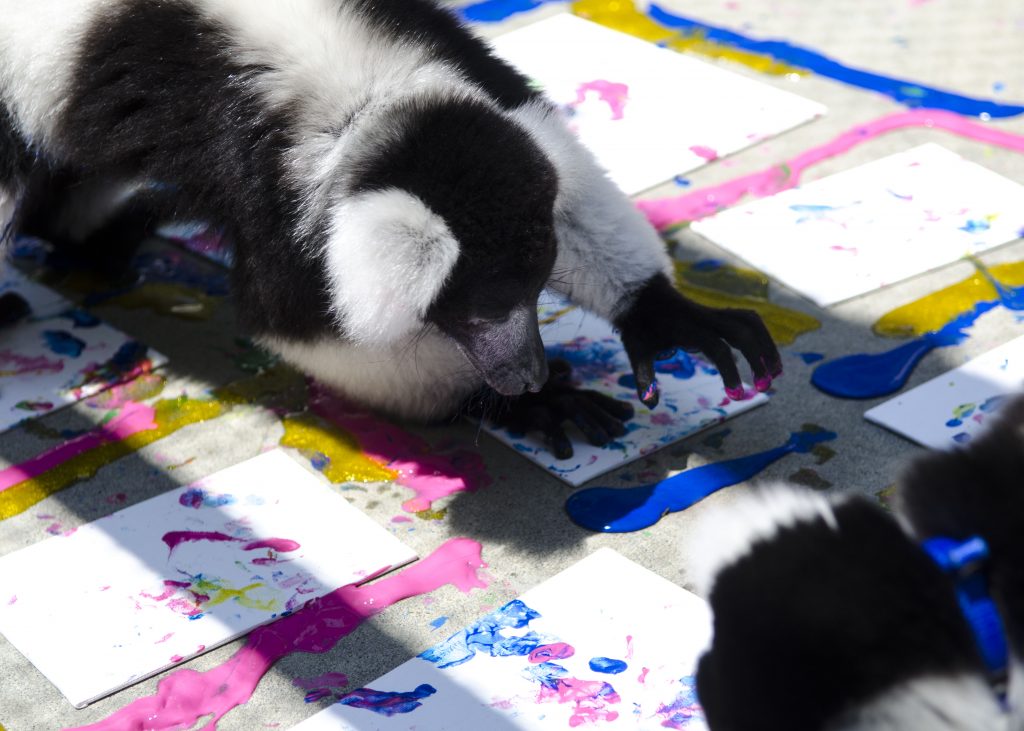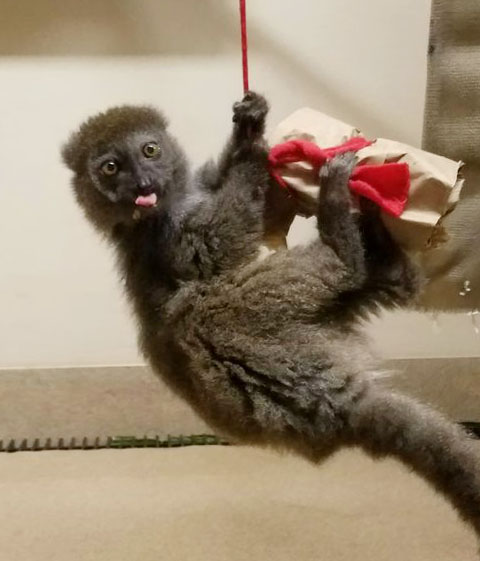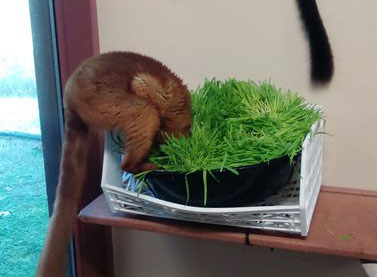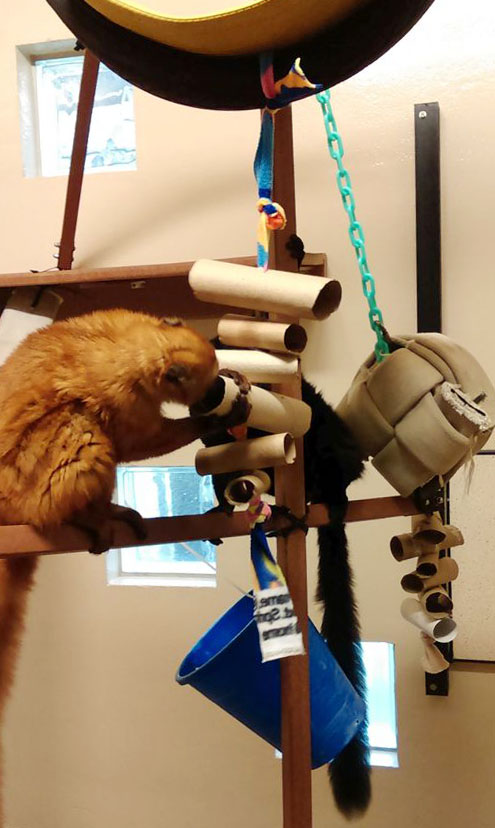
Primate Technicians have many, many options for providing enrichment to the DLC’s lemurs — including painting! Not only does painting promote natural foraging behavior, but the feeling of paint between the toes, the new smells and colors, and the springiness of the canvas are fun ways to keep the lemurs both physically AND mentally engaged.
Lemurs are intelligent, and because they’re intelligent, they can get bored. So, 365 days of the year, the DLC’s dedicated Primate Technicians help ensure that our lemurs’ lives are interesting. One of those technicians is Kate Byrnes, a four-year veteran of the DLC who works closely with Curator of Behavioral Management Meg Dye to provide novel sources of enrichment for the DLC’s lemurs every day.
Daily enrichment is an essential part of animal welfare to promote curiosity, exploration, and mental stimulation. Enrichment pertains to the provision of stimuli (usually to an animal living within human care) for the sake of exercising the animal mentally, emotionally, and physically. Animal enrichment is not so different from how our restless brains itch for activities to preoccupy our busy minds.
The DLC uses a holistic approach to enrichment, as there are many opportunities and methods to create a stimulating environment. For example, enrichment can pertain to changing the structure and complexity of the environment around the animals; training the lemurs to participate in their own health care, such as walking on to a scale; and introducing new smells, puzzle boxes, or sights, such as mirrors. Additional opportunities that can be very enriching to a lemur include the arrival of new neighbors, painting with non-toxic paint to create DLC artwork, and non-invasive research such as touch-screen puzzles.
Although animal care staff have a large number of pre-approved items and methods to choose from, creating brand-new forms of enrichment is rewarding for both lemurs and staff. The creation process begins by defining an objective. “When I’m trying to think of a new [enrichment] item, first thing I think is: what’s my goal?,” Kate says. Goals might be trying to get the lemur to be more active or to promote certain natural behaviors like foraging.
“A lot of people think that enrichment is just throwing toys to the animals,” says Kate. “But we’re actually trying to elicit a certain behavior or response. A lot of thought goes into it.”
Once the goal behind the enrichment is established and the specifics of the new enrichment have been identified, it is time for the next step. Any time a new item is created, animal care technicians like Kate must go through a structured approval process. The approval process assures that the veterinarians, curators and animal care supervisor have reviewed the item for safety concerns including any potential for ingestion, entrapment, or injury to a lemur. “The number one priority is making sure the item is safe,” Kate says.
Once the item is approved, Kate moves to the best part – seeing what the lemurs think of the idea. “It’s a lot like research,” she explains. The lemurs are monitored closely, and any interactions with the enrichment are recorded. If the enrichment is not eliciting the desired response or is not as exciting and novel to the lemurs as it could be, the technicians will revise it and reintroduce it to the lemurs.
“We always think [providing scents] are going to be a great success,” she says, “but for animals that are so highly scent-oriented, the lemurs just don’t seem to be interested.”
Behavioral-based enrichment is essential to promoting species-specific behaviors, encouraging lemurs to act and behave as they would in the wild. Presley, a male blue-eyed-black lemur, regularly has the tree branch installations in his enclosure scrubbed down. Why? Presley is a keen scent-marker. Like most other lemurs, he spends a lot of time dispersing his unique scent by rubbing specialized glands on his forehead, wrists, and the base of his tail onto the various structures inside his enclosure.
In the forests of Madagascar, scent-marking is critical behavior for lemurs. It allows for communication between animals, can announce when a female is ready to breed, and establishes territory, among many other things. When Presley’s keepers wipe away the scents left in his enclosure, it prompts him to work on restoring them.
Training, too, is an excellent form of enrichment. All Primate Technicians complete a course with Meg Dye, learning how to use positive reinforcement to train the lemurs to sit on a scale, enter a kennel, move to a certain spot, or other behaviors that may seem like play to the lemurs but serve a purpose if needed.
“The training is 100% voluntary for the lemurs,” Kate says. “If they don’t want to participate, they don’t have to. But if they do, they get an extra little [usually food] reward.”
A classic example of how training is beneficial to both lemur and technician is when a lemur needs a regular check-up by a veterinarian. Lemurs are trained to enter carrier kennels for transportation from their enclosure to the veterinarian’s room. By using this method, neither sedation nor handling of the animals is required.
“Training is based on mutual trust between the technician and lemur,” says the DLC’s Curator of Behavioral Management, Meg. “Similar to students in a classroom, training sessions consist of small achievable steps that set the lemur up to succeed. We’ve all experienced that wonderful teacher who made learning fun. That is exactly what each technician does as they teach the lemurs to participate in husbandry and research behaviors.”

Hiding food in a paper bag is one form of enrichment — and for some lemurs, hanging it in the enclosure takes the challenge to the next level! It’s safe to say that every lemur approaches the enrichment differently…!

On cold weather days, lemurs aren’t able to spend much time outside. This has inspired experimenting with growing wheat grass! It is relatively easy and only takes about a week before it is ready to go into an enclosure. We have been using it as a novelty item and as a place to hide food! The roots are strong enough that it can also be easily taken out of the planter so it can go in with animals that cannot have plastic or rubber!

Paper towel rolls tied together with fleece are great for hiding food in an enclosure and are easy for volunteers to help create!

Check out these adorable mealworm feeders! Bevan, one of our lead Primate Technicians, plugs one end with melon, puts in a mealworm, then plugs the other end with some melon. Great enrichment for the mouse lemurs!

